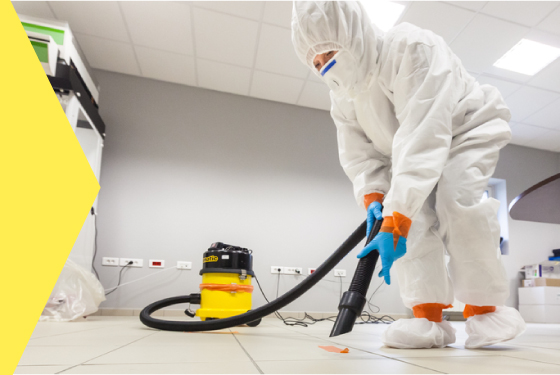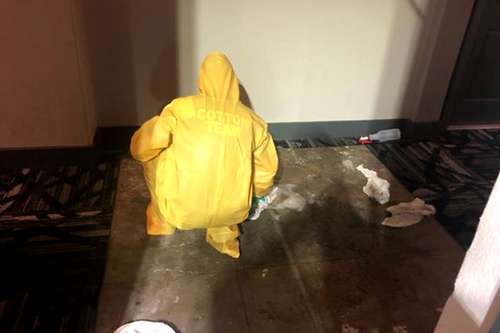Hoarder Cleanup Providers: Improving Order and Safety in Your Home
Hoarder Cleanup Providers: Improving Order and Safety in Your Home
Blog Article
Professional Biohazard Cleansing and Decontamination for Blood, Bodily Fluids, and Hazardous Products
The possible health risks associated with exposure to biohazards underscore the critical need for careful handling and thorough cleaning. As we navigate the intricate landscape of biohazard cleanup, recognizing the subtleties of guidelines, compliance, and the customized tools at play becomes necessary in guaranteeing a risk-free and detailed purification procedure.
Health Risks of Biohazard Exposure
Direct exposure to biohazards postures substantial health dangers that can result in extreme effects for people and neighborhoods alike. Biohazards incorporate a vast array of organic compounds, consisting of blood, physical liquids, mold and mildew, microorganisms, viruses, and various other possibly contagious materials. When individuals enter contact with these biohazards, whether with mishaps, improper handling, or ecological exposure, they face the threat of contracting severe health problems or illness.
One of the primary health and wellness threats connected with biohazard exposure is the transmission of infectious diseases. Bloodborne microorganisms such as HIV, liver disease B and C, and different microorganisms can be existing in biohazardous materials, positioning a straight threat to human health. Inhaling air-borne biohazards like mold and mildew spores or entering into contact with contaminated surface areas can also lead to respiratory system issues, allergic reactions, and other unfavorable wellness impacts.
Furthermore, biohazard exposure can have long-term wellness effects, with some diseases materializing years after the first get in touch with (Blood Cleanup). As a result, it is crucial to prioritize proper biohazard cleaning and purification to mitigate these wellness dangers and make certain the safety of areas and individuals

Specialized Educating for Biohazard Cleaning
When it pertains to dealing with biohazard cleaning effectively and safely, specialized training plays a basic duty in guaranteeing proper decontamination procedures are complied with. Biohazard cleaning needs particular knowledge and skills to efficiently alleviate risks connected with bloodborne pathogens, physical fluids, and unsafe products. Experts educated in biohazard cleanup go through strenuous instruction on how to safely handle, remove, and get rid of biohazardous materials to avoid contamination and exposure.
Specialized training for biohazard clean-up covers a variety of necessary subjects, including appropriate individual safety equipment (PPE) usage, bloodborne pathogen understanding, purification strategies, and dangerous waste disposal protocols. People educated in biohazard cleaning are geared up with the needed competence to examine contamination levels, identify potential hazards, and implement ideal cleanup treatments in compliance with regulative requirements.
Constant training and education and learning are vital in the area of biohazard clean-up to stay upgraded on the most recent purification modern technologies, security methods, and laws. By buying specialized training, biohazard cleaning specialists can efficiently react to emergency clean-up circumstances and secure both public health and the environment.
Value of Proper Decontamination Strategies
Making use of correct purification methods is important in biohazard cleanup to successfully get rid of unsafe products and reduce health dangers. Effective purification not only ensures the removal of visible traces of blood, physical fluids, and other biohazards however likewise targets unseen microorganisms that might present major wellness hazards if not properly eliminated. By adhering to rigorous decontamination methods, trained experts can considerably lower the risk of exposure to harmful microorganisms, viruses, and bacteria that can lead to conditions or infections.
Appropriate purification strategies Blood Cleanup include making use of specific tools and disinfectants that are particularly developed to neutralize biohazards properly. Complete cleansing and sanitation of infected locations are important to stop the spread of microorganisms and make sure a secure atmosphere for owners. Furthermore, the proper disposal of biohazardous waste adhering to decontamination treatments is crucial in stopping contamination of other surface areas or people.

Tools and Tools for Safe Clean-up
When dealing with blood, bodily fluids, or harmful products, biohazard cleansing specialists rely on specialized gear to decrease direct exposure threats and completely sanitize the affected area. In addition, biohazard cleaning sets including anti-bacterials, absorptive products, and biohazard bags are made use of to safely consist of and get rid of of infected things.
Advanced cleansing devices like hospital-grade anti-bacterials, HEPA-filtered vacuum cleaners, and fogging makers are utilized to sterilize surfaces and get rid of biohazards effectively. Specialized devices such as sharps containers and biohazard garbage disposal containers are used to safely handle sharp items and biohazardous waste products. By making use of the right tools and tools, biohazard cleansing specialists can guarantee a detailed cleaning process that focuses on safety and decreases health and wellness risks for both employees and residents of the affected room.
Regulations and Conformity in Biohazard Cleansing
Proper adherence to policies and compliance requirements is paramount in biohazard cleaning to make certain the security of both personnel and the environment. Federal government firms such as OSHA (Occupational Security and Health And Wellness Management) and the EPA (Epa) have actually established details guidelines for biohazard cleanup treatments to lessen health and wellness risks and environmental contamination. These policies cover a series of aspects including the handling, transportation, and disposal of biohazardous materials, as well as the needed training and safety equipment required for employees included in the clean-up procedure.
Biohazard cleaning firms must remain updated with these policies to ensure that their operations meet the called for security requirements. Failing to follow these guidelines can cause extreme consequences, including penalties, lawful action, and endangering the health and wellness of individuals and the environment. By complying with rigorous regulations and compliance procedures, biohazard cleaning firms can effectively minimize dangers and ensure a safe and comprehensive clean-up procedure for all events entailed.
Conclusion
Finally, biohazard cleaning and decontamination require specialized training, proper techniques, and adherence to laws. Direct exposure to blood, physical fluids, and unsafe materials poses substantial health and wellness dangers, making it vital to make use of the best devices and devices for safe clean-up. By adhering to strict methods and standards, experts can properly minimize the threats associated with biohazard direct exposure and guarantee the safety and security of both themselves and others.
As we navigate the complex landscape of biohazard cleanup, comprehending the subtleties of policies, conformity, and the specific devices at play comes to be necessary in guaranteeing a risk-free and detailed purification process. (Blood Cleanup)
When it comes to taking care of biohazard cleanup effectively and safely, specialized training plays an essential duty in ensuring correct decontamination treatments are complied with.Utilizing correct decontamination methods is important in biohazard cleanup to efficiently remove hazardous products and minimize health threats. In addition, biohazard cleansing packages consisting of disinfectants, absorbent products, and biohazard bags are utilized to securely dispose and include of infected products.
Federal government companies such as OSHA (Occupational Security and Wellness Management) and the EPA (Environmental Protection Firm) have actually established details guidelines for biohazard cleanup procedures to decrease health and wellness risks and environmental contamination.
Report this page